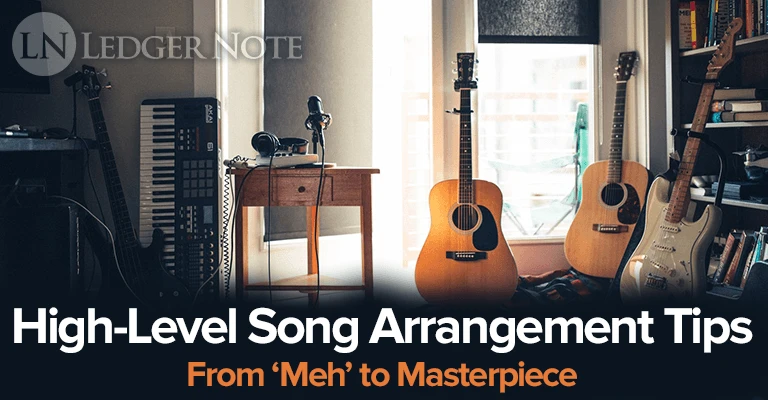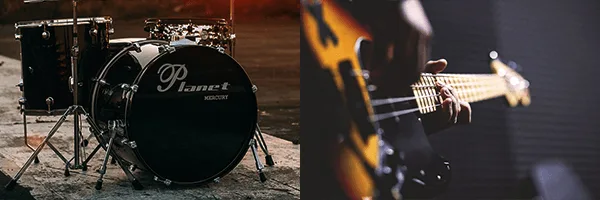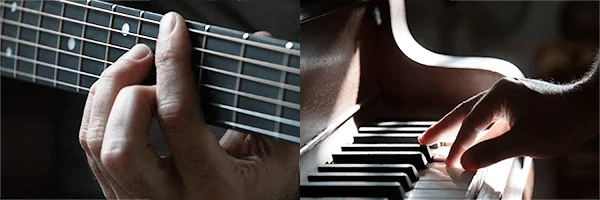
So you’ve written a great song. Now what? Most songs call for more than simply the original skeleton of voice and piano or guitar. But just how do you arrange when you’re starting with these bare bones? What do you add to the orchestration and where do you add this to the song?
Here we’ll offer some tips to help you create a quality song arrangement, lending some insight on the elements that will serve your song, including sparsity and density, simplicity and complexity, extracurriculars like horns and strings, and finally how arrangement can turn a song into a journey.
A problem with amateur arranging is the impulse to let every instrument sing out at all times, falling for the old “more is better” trap. That is definitely not the case when it comes to professional music. A better motto would be “there is a right time and place for everything.”
The ideas are simple, but executing them effectively within your own music where you may begin to lose perspective is a real challenge. But it is not one that can’t be overcome with the tips and tricks provided in this article.
It should be mentioned that if your efforts fail, you can always hire experienced arrangers, such as the crew over at Supreme Tracks, who I’ve personally seen take a simple framework of a song and turn it into a radio-ready masterpiece with the help of their team of studio musicians.
Don’t fool yourself into thinking that finding help is cheating. You’d get the label of principal songwriter, meaning the core of the work is of your creation and most of the credit goes to you.
Anyways, let’s jump right in by deciding which instruments can complement your bare bones song.
How to Arrange Music: Creating Your Ensemble
When selecting instruments for your track, think like a painter choosing colors. Look at the lyrics of your song and the story you are telling, and let that determine the vibe.
Always ask yourself, “will this serve the song?” Make sure you’re serving the artistic expression of the music and not your own ego as a songwriter.
Take a look at your options for drums and bass. What kind of beat, on what kind of kit or percussion instruments, with what kind of player will heighten the listener’s experience of your story? Or would programmed drums work best? Will an upright, electric, or synth bass be the best fit?
Especially during the recording phase, pay close attention to the relationship between the kick drum sound and the bass sound. If this partnership fits well it can take your track to the next level, and makes mixing the low-end a lot easier.

After the rhythm section is in place, your harmonic instruments will contribute the real color to your song. Should you use acoustic or electric guitar? If electric, what kind of tone and what kind of player? Does the song call for acoustic piano, Rhodes, Wurlitzer, organ, or synth?
Maybe a combination of a few? And what kind of player will help illuminate your story? You’re only limited by your ability to envision a better end result for your song.
Most of the time, if you assemble some wonderful players, they will be able to learn your song and create and execute some great arrangements on their own.
It may be exhilarating to hear your music come out of the fingers of your players. If you have a different idea of how it should sound, work together to find common ground.
If you’re working with an experienced and talented musician, trust them and be open minded about their ideas about what they should play. The master of a specific instrument will understand their role better than the jack-of-all-trades. Remember, you asked to work with them because you trust them.
Your last basic element will be vocals. Of course you will have your lead vocal: whether you’re working with a male or female vocalist may be decided by your lyrics. Remember that the timbre of the voice can vastly change the vibe. Who will serve the song best?
Then, decide on a key that will set the vocalist up for really nailing the song. It’s likely the case that you wrote this song for yourself and this decision won’t matter because you’ll be singing it. All you can do when under these non-negotiable scenarios is practice and then practice some more.
Lastly, arrange the harmonies! Would a single harmony be best? Maybe a group? How about a choir? Many times the places that call for harmonies are the choruses of your song, or certain melodies or lyrics you’d like to highlight.
This can be done with an instrument or additional vocals. Choosing the instruments to color in your song and highlight is as important as deciding and composing what they play.
Song Arrangement: Sparsity vs. Density
Once you have your ensemble in place, you have the full range of their sound at your disposal. How sparse or how dense should the arrangement be to serve the song? Too sparse, and it sounds like there is no foundation. Too dense, and it is distracting and busy.
Of course, you’ll dance between the two to some degree, which we discuss further into the article. Just remember, the lead can’t shine if it’s not being supported tastefully or if it’s being drowned out by too much instrumentation.
One way to make sure you’re at the sweet spot between these two extremes is to make sure your harmonic instruments (guitar and keys) are playing in different ranges, and hopefully playing different parts. Perhaps one is holding down the chords, while the other is playing tasteful melodic figures that support the vocals.
You’ll notice that the strum of a guitar has a completely different color than a piano playing your chord progression. Also, different sections of your song will call for different densities.
The verse is generally more sparse, and the hook leans towards a more filled-out sound, although you can apply the opposite treatment too, depending on the song.

Pro-Tip: Density does not determine dynamics. Just because a chorus is fully colored-in doesn’t mean it has to be performed at high energy or volume. Conversely, sometimes a sparse arrangement like a kick, a snare, a baseline and a vocal can pack a powerful punch.
How to Arrange a Song: Simplicity vs. Complexity
Another plane on which to utilize your elements is when you deal with simplicity and complexity. Even if the most skilled musicians are playing your song, just because you can play something doesn’t mean you always should.
The key to writing great parts is choosing the most tasteful alternate melody, embellishment, or reharmonization. Always remember that the primary purpose of any addition is to serve the song. Sometimes that jaw dropping electric guitar solo, or that arpeggiating classical piano style can really heighten your story and attract an otherwise unimpressed listener.
Other times, you’ll struggle to let a good idea go even when it doesn’t fit in the song like it should. Be aggressive and leave it on the cutting room floor.
In contemporary pop songwriting, a simple arrangement will usually get the most people tapping their feet, but never underestimate the power of throwing in an advanced musical idea like a jazz-inspired reharmonization or a gospel-inspired bass fill.
Pro-Tip: Listen to your favorite songs and study their arrangements. What alternate melodies have the players contributed? How do they serve the song-writing? You’ll be able to develop your aesthetic faster by studying the greats.
Music Arrangement Theory: Extracurriculars
Next, think outside the box, or in this case, the four piece band. Consider the role of strings, brass, acoustic & percussive sounds, and even digitally produced noises could have in your songs.
Would a violin, cello, or a string section serve your song? Take a listen to “What’s Going On” by Marvin Gaye below, and study how the string section contributes to the songwriting.
This song (and the whole album) carries a profound message of equality and peace on earth. The strings add an epic, grand, orchestral color, and evoking the symphonic era makes the song feel timeless.
Would a saxophone, or a whole horn section serve the song? Take a listen to Earth, Wind, and Fire’s “September” below (one of the most played songs in the U.S.), notice the intricate horn arrangement.
Sometimes they provide alternate melodies, while others they are playing thick, percussive chords. They almost serve as the vocal’s partner, and their duet results in one of the funkiest songs ever written.
In more contemporary songwriting and producing, anything from the most acoustic sounds (check out Bon Iver’s album “For Emma, Forever Ago” to hear some pots and pans) to the most digital sounds (see Daft Punk’s robot music) can be used to cultivate your own unique sound as an artist. Don’t be afraid to break out in new directions.
Pro-Tip: Don’t force it! If the song calls for a more bare bones arrangement, be true to the integrity of the song. Some of the most moving songs are performed by one guitarist and a singer, like a lot of the work of James Taylor or John Denver. Your listener will appreciate a tasteful, sensitive arrangement that serves the song.
Turn Your Song Arrangement Into A Journey
Most listeners appreciate music that builds, that ebbs and flows, that is dynamic and interesting.Your tasteful arrangement can imbue each section of your song with its own unique meaning and aid in smooth and story-serving transitions.
Little splashes of what I call “ear candy” can go a long way to keep the listener intrigued and focused as you allow the music to breathe and build its way through your song structure.
When transitioning from a first verse to first chorus, try adding a new instrument or two, and perhaps some vocal harmonies. Then in the second verse, keep some or all of your new elements in.
This will give the listener a new experience with something they’ve heard before, so use your arrangement (and hopefully your awesome lyrics) to keep them engaged. You can then drop all of it out again and rebuild from the post-chorus tag throughout the verse and into the next chorus.
Your bridge is a great place to experiment with some different sounds. If it will serve your lyrics and story, try breaking it way down at the beginning of the bridge, and build in density and complexity throughout its entire length.
The build’s climax will be the downbeat of your final chorus: a riveting moment that could either get a crowd on their feet during an upbeat song, or illicit tears in a ballad. This is where you can break out all of your instruments and drive the point home.
Pro-Tip: A killer arrangement will not save a poorly-written song. A great recipe could produce a terrible meal with spoiled ingredients! The foundation of the song is everything. If the bare bones version isn’t good, then you need to keep working on it.
Song Arrangement Made Easy
Some musicians devote their lives to arranging and orchestrating. It is a craft that requires sensitivity, deep listening, good taste, creativity, and knowledge of all the musical hues on the color wheel.
In modern music, most producers are doing this job all on their own with samples and recording software, so it must be an attainable goal. The competition is getting stiff out there, though!
Using these simple tips and studying your favorite tunes will help you achieve high quality and inspiring arrangements for your songs. If all else fails, you can always inquire about the professional song arrangement services and hire professional arrangers to make the best possible arrangement for your song. Best of luck and happy arranging!